Acquisition reports
Acquisition reports help interpret the source of visitors to your website. Think about a website that you have visited recently. How did you get there? Did you click a link from a friend's Facebook post? Did you come across the site while searching Google? Did you see an ad on a website which was exactly what you were looking for?
As a product manager or website owner, it is very important to know how people find your site. If they link to your site from another website, then which site was it? If they found you with a Google search, then what did they type into Google that resulted in your website showing up?
Google Analytics helps answer these questions.
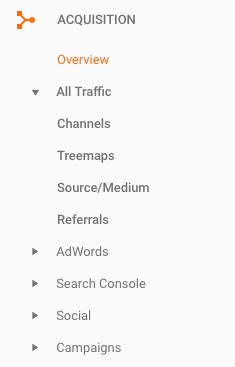
Let's look at four of the most frequently-used reports in the Acquisition section of Google Analytics:
All Traffic report
Channels report
Referral Traffic report
Search Engine Queries report
1. All Traffic report
This report is great for understanding "where visitors come from" and "how many visitors come from each source."
In the diagram below, you can see that 44.4% of your visitors come from an organic search (this means that they are typing some keywords into a search engine like Google). We also see that 21.8% is direct traffic (people typed the website address directly into their browser), and 16% of traffic was referral (meaning another site linked to your site).
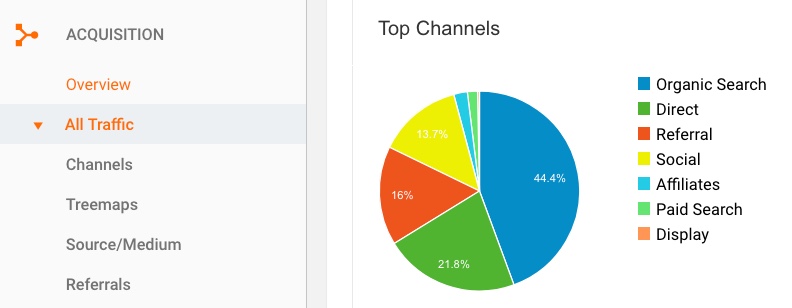
These various sources are referred to as channels in Google Analytics.
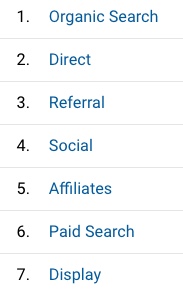
Let's take a closer look:
Organic search, as we said above, is when a user types a term into a search engine like Google or Bing. For example, someone may type "buy flowers New York city" into Google and get a set of search results. When a user clicks one of these search results to visit your site, the "source" is considered an "organic search." Basically, it means someone found you through a search engine.
A site gets direct traffic when a visitor knows the URL and types it directly into their browser, or they have added a bookmark to this site in their browser. Domain names that are easy to remember are valuable because they result in direct traffic.
Referral traffic refers to when another site puts a link to your site on theirs. An example of this would be if a blogger writes an article about a product that you sell on your site, and links to it. In fact, if I provide a link to http://www.bbc.co.uk, then I am referring to the BBC website.
Social is traffic from any social channel including Facebook, Twitter, Instagram, Snapchat, YouTube, LinkedIn, and more.
Affiliate traffic is when another site is paid a commission for sending traffic to your site that results in a commission being paid to them if that traffic results in a purchase.
Paid Search is when you pay for ads on an advertising platform like Google Adwords that results in a visit to your site.
Display refers to an advertisement (like a banner) that just appears on websites that visitors click.
Knowing which channels send traffic to your site is important because when you know where visitors are coming from, you can make sure that experience is the best it can be. For example, if most of your visitors come from social media, you may want to prioritize the social media experience over improving other things in your website or product.
2. Channels report
Although you have identified which channels send you the most visitors, you need further reports to determine which channels are sending you the highest-converting visitors.
For example, imagine that you get a lot of traffic from social media, but they never purchase anything on your site. You get very little traffic from paid ads, but every visitor from a paid ad spends lots of money! This illustrates why you care about which channels send you a lot of traffic and which channels send you traffic that converts well (in this case, converting from just being a visitor to being a visitor that makes a purchase).
The Channels report shows you a list of channels that send traffic to your site with the following type of information for each channel:
Acquisition
Behavior
Conversions

You have to define in Google Analytics which events you regard as a conversion. For example, a conversion may be someone buying a product, downloading a PDF, or signing up for your newsletter. Once you have done this, you can see which percentage of visitors will take actions that you care about. This helps to understand the performance of each channel side-by-side!
3. Referral Traffic report
This report lets you see which other websites are sending traffic to your site. When another site links to your site, users will visit your site if they click this link.
This report yields very valuable, actionable information. If a site sends a lot of traffic because a blogger wrote a favorable product review, then you can determine which bloggers/sites are beneficial to you encourage them to do even more publicity of your site.
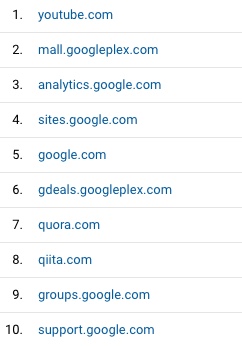
4. Search Engine Queries report
The words that users type into the search engine are called search query. For example, if someone types "Italian restaurant Berlin" into Google search, then "Italian restaurant Berlin" is the search query. The Search Engine Queries report helps to understand which exact search queries send the most traffic.
This information can help you to make sure that your site experience is aligned with what your customers are looking for (in their own words) and can inform you which landing pages and content could be valuable to create.
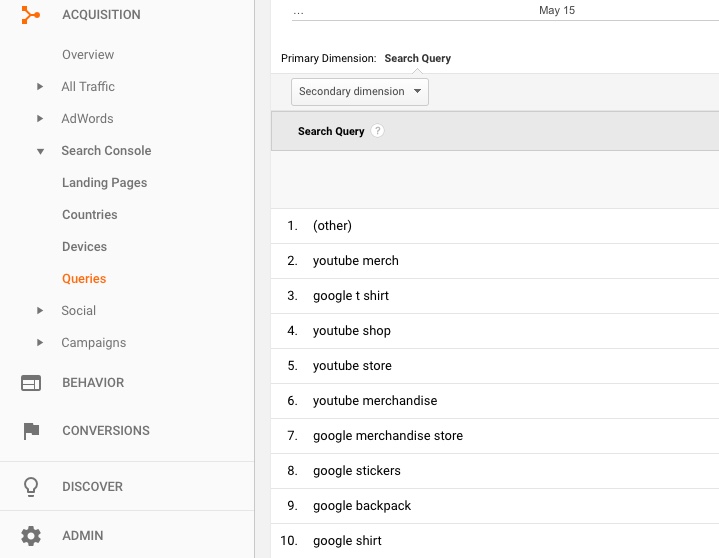
You also can view the click-through rate for each search query.
This is the ratio of how many times users clicked on a link to your website/how many times your website link appeared.
How to interpret acquisition metrics
Here are a few examples of how you could interpret the acquisition data you access in Google Analytics to help decide a future course of action:
By understanding the channels that get the most traffic and the conversion rates per channel, you can decide which experiences are the most important to improve.
You can decide where to allocate your advertising budget.
If conversion is very good on a channel, you may want to increase your advertising budget if that would be instantly profitable.
You can improve your search engine optimization strategy so that your site will rank well for specific keyword terms in search engines.
You will see which sites send traffic to yours so that you can do more of what worked previously. For example, which journalists or bloggers sent converting traffic? Can you get more of those types of authors and sites to write about your site or products?
In the next chapter, we take a look at the behavior set of reports in Google Analytics.
Summary
Google Analytics has a set of acquisition reports that help you to understand where your visitor traffic comes from.
In particular, Google Analytics helps you to understand:
The source of visitors to your site - with the All Traffic report.
Which channels perform best - with the Channels report.
Which specific sites are sending you the most traffic - with the Referral Traffic report.
What keywords people typed into search engines - with the Search Engine Queries report.
Additional resources
A nice guide on researching search engine query keywords.
